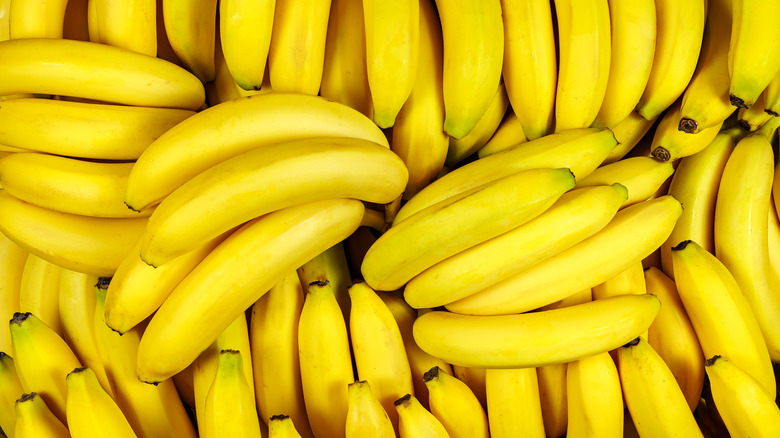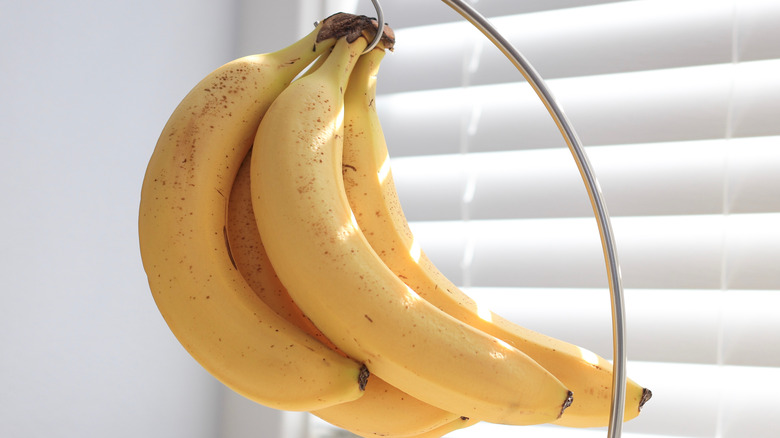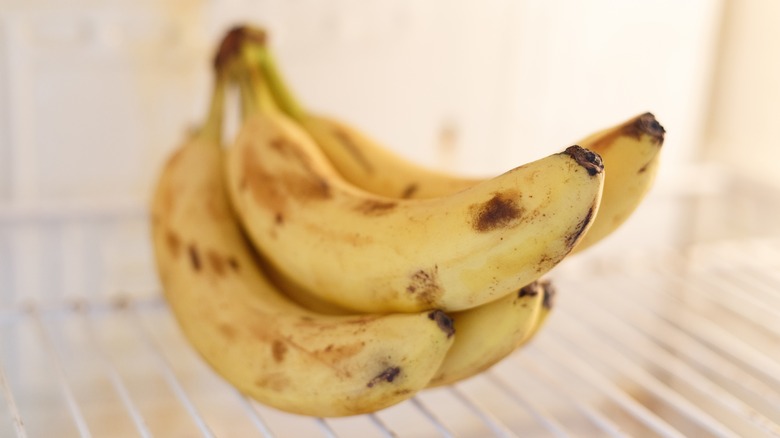Should You Store Bananas In The Fridge Or At Room Temperature?
Keeping a bunch of bright yellow bananas in a fruit basket on the counter is not only visually appealing, it's a great way to ensure you see — and thus eat — them frequently. But wait a couple of days too long, and those beautiful golden bananas turn brown and soft. And while they're perfectly edible for a few days more, many people feel they become less appetizing. So perhaps storing bananas on the counter isn't the best option. But what's going to keep bananas better longer: Storing at room temperature or nice and cold in the refrigerator?
It turns out the answer is...both. Your first clue is the grocery store. Bananas are displayed, unrefrigerated, in the middle of the produce section, or along end caps near checkout. Amazon even used to have a banana stand set up on the streets of Seattle, handing out free bananas to anyone who passed by.
Green bananas do best at room temperature, where they continue ripening. As they develop brown spots and begin softening, some people pop them in the fridge. It slows the ripening process, so it's an option as well. But even the refrigerator can't work miracles. Since buying single bananas mostly happens only at Trader Joe's, it's wise to understand best-storage practices for maximum potassium enjoyment.
When to store bananas on the countertop
Like avocados, mangoes, and a handful of other fruits, bananas are often displayed in stores while they're still green and unripe. This extends the marketable shelf life several days, ensuring stores will sell most of them before they turn brown. But green bananas aren't all that tasty. They need another day or two to ripen to yellow and firm, and lose their bitterness. Hang them on a banana hook, and they'll transform nicely without bruising.
It's not worth putting green or bright yellow bananas in the refrigerator. It slows the ripening process, and you're stuck with green bananas. Additionally, it's possible to inhibit the ethylene action required to properly mature bananas. (They're are a so-called climacteric fruit and need to produce that sweet, sweet, ethylene gas to sweeten and soften.) This is technically known as chilling injury, and results in bitter fruit and vascular browning. While letting green and new yellow bananas ripen on the countertop is ideal, remember to store them away from other fruits: that same ethylene gas will impact other fruit, ripening them too quickly and ruining them.
When to store bananas in the refrigerator
Technically, you never have to store bananas in the fridge. Some people like their bananas brown and mushy, becoming first sweeter, then developing that intense, fake banana flavor. Plus if you don't want to eat them, it's easy enough to convert brown bananas into smoothies or Martha Stewart's heavenly banana bread.
If brown spots are a harbinger of doom for you, pop bananas into the fridge (again separating them from other fruits and veggies). This will slow the aging process, and you can enjoy the slightly browned bananas for a longer period. In fact, the flesh stays tasty longer as the skins brown, though you may have a hard time convincing picky eaters. The good fortune won't last forever: eventually they turn black, and just don't taste good. If you still haven't gotten to those last few dark brown fruits — whether in the fridge or on the counter — there's another option. Peel them, slice into thirds or smaller chunks, and place in an airtight container. Pop these mushy, peeled bananas in the freezer, where they'll last for several months, ready for smoothies, banana bread, or as an egg substitute in cakes.


